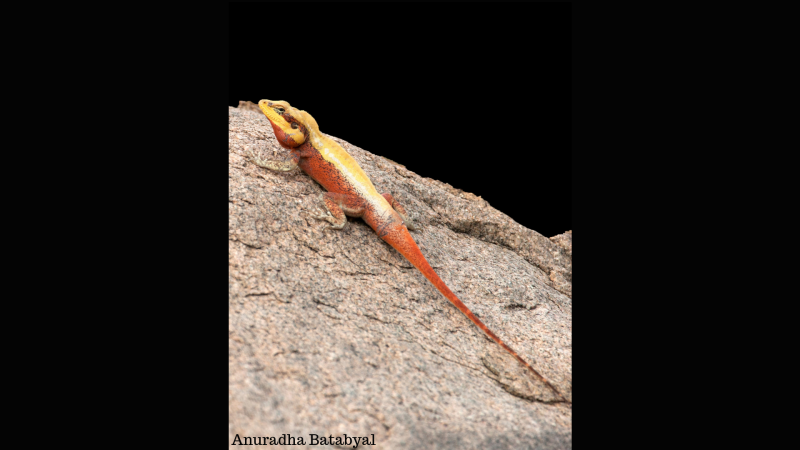
For the Indian rock agama, gardens and construction plots are some of the last few refuges in densely built-up, seemingly inhospitable cities. But even these safe houses are not entirely without stressors, and these tropical lizards are doing their best to cope with the challenges of living the city life.
In a recent study, published in the journal Frontiers in Ecology and Evolution, Ms. Madhura Amdekar and her colleagues at the Indian Institute of Science, Bengaluru, have tried to understand whether urban environments adversely affect the health and fitness of these lizards. The study was supported by grants from the Department of Biotechnology, Department of Science and Technology, Ministry of Environment, Forest and Climate Change, and British Herpetological Society.
Using physiological measures, the ecologists set out to determine whether the lizards were urban ‘exploiters’ or ‘adaptors’. Urban exploiters are those that thrive in human-dominated landscapes, often doing better than their rural counterparts, while adaptors do just as well in urban areas compared to rural areas. Their research also highlights the importance of using more than one health measure to ascertain species’ response to stressful environments. Their multi-pronged approach, using five such health measures, led them to find that Psammophilus dorsalis, the agama in question, is, in fact, an urban adaptor.
If the lizard were an urban adaptor, it would show reduced immunity or higher levels of stress - both by-products of active coping mechanisms in a less-than-ideal environment. Accordingly, they compared five indicators of health between urban and rural agamas and found significant differences in two of them, indicating that urban agamas are actively coping with the pressure of living in the disturbed habitats of cities.
This active coping could mean one of two things for the rock agama. “Over a period, due to habituation, adaptors may achieve similar physiology in urban areas as compared to rural areas. Alternatively, if environmental disturbances increase beyond their tolerance levels, adaptors may exhibit greater compromised physiology”, posits Ms. Amdekar.
So far, in Bengaluru, where the team found their urban specimens, the lizards seem to be troopers. In some ways, they behave differently from rural populations, allowing closer approaches before they flee and identifying safe spots quickly. Outside cities, rock agamas are commonly found in semi-arid savannas, and their natural habitat is littered with scrub vegetation and large boulders. Being ectotherms, these landscape features that provide areas to bask and cool down, via a process known as thermoregulation, are vital to the survival of these lizards.
While cities like Bengaluru have many parks, such areas don’t make suitable habitats for the rock agama. “City parks that are overly manicured are not going to have insects to eat, or places to thermoregulate, which is why most parks at the moment are not designed for lizards like the rock agama. Hence they are found in other pockets of suitable areas in the city, but these are also not completely ideal, which is why we see signatures of active physiological coping”, explains Prof. Maria Thaker from IISc, who was the senior author in the study.
Many studies that look into these coping mechanisms often consider only one or two measures of immune response, because they are often limited by how invasive these techniques are, or because the focus of such studies is more wide-ranging. For example, they may focus on “examining trade-offs between immunity and some other physiological process like reproduction. Therefore, a couple of parameters that represent each of the physiological processes under examination are typically measured”, says Ms. Amdekar. However, in this study, the researchers not only considered five measures of immunity but also found that they did not influence each other for the most part - they were all separate indicators of health in the agamas.
Taken alongside the fact that only two out of five tested measures showed that the lizards were effectively coping (as urban adaptors), the researchers emphasise the need for future studies to consider a higher number of immunity measures. These physiological indicators of animals living outside their natural environments can be useful tools to differentiate urban exploiters and adaptors. Such differentiation allows scientists to come up with more informed plans for the management of species in disturbed, human-altered areas.
For the metropolitan Indian rock agama, we could help by giving it the likeness of its natural home. Even though there seem to be no major health consequences from living in cities right now, “retaining natural areas as scrub savanna habitat, with boulders, bare soil and scrub vegetation in the city would help with the persistence of urban populations of lizards”, remarks Ms. Amdekar. In the face of increasing urbanisation, conserving biodiversity takes on a new urgency. Protecting species that are part of delicate ecological networks is imperative, especially when we’ve just begun to understand the complexity of urban ecosystems.





